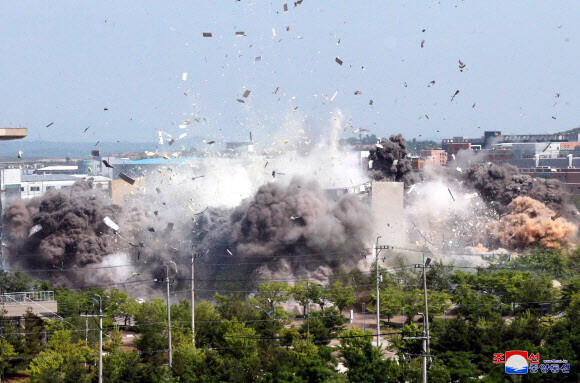hankyoreh
Links to other country sites 다른 나라 사이트 링크
S. Korea deliberates over how to respond to N. Korea’s destruction of joint liaison office

South Korean government officials are debating the level and methods of response after North Korea’s demolition of the Inter-Korean Joint Liaison office in Kaesong on June 16 and its subsequent denunciation of President Moon Jae-in.
Seoul’s future response is seen as very likely to proceed along two paths. The first involves emergency actions to prevent the situation from deteriorating further. A “hint” along these lines can be found through a close reading of a statement published on June 17 by Workers’ Party of Korea (WPK) Central Committee Deputy Director Kim Yo-jong. In it, she cited the “scattering of anti-DPRK leaflets” as a reason for the “present grim situation” and referred to an “apology, repentance and firm pledge [from Moon] to prevent the recurrence of similar occurrences.”
But the harsh wording of Kim’s remarks directly targeting Moon suggests the Blue House and administration are unlikely to be able to produce a “statement of dismay” or other measure to satisfy Pyongyang. One option that remains available is to work to prevent future launches of balloons containing propaganda leaflets across the border. Currently, two Border Area Support Act amendments have been submitted in the National Assembly to this end. Meanwhile, Gyeonggi Province and the city of Incheon independently designated the North Korean border as a “risk zone” and issued administrative orders that day barring access to individuals and groups scattering leaflets.
Preventing launches of balloons likely to be first response to keep situation from deteriorating furtherThe second avenue involves response measures to turn the situation around. The cold reality is that no sure solution appears in sight at the moment -- as North Korea continues presenting basic demands that the South is unable to find easy solutions for. In his New Year’s address in January 2019, North Korean leader Kim Jong-un demanded a resumption of operations at the Kaesong Industrial Complex and tourism at Mt. Kumgang and a halt to joint South Korea-US military exercises. But the conditions to achieve this failed to materialize after a second North Korea-US summit in Hanoi broke down without results on Feb. 28 of that year. Conscious of this, Moon stated in his June 15 South-North Joint Declaration 20th anniversary speech on June 15 that the “situation is not yet one where South and North are free to do whatever they intend.” The result of this was Kim Yo-jong’s statement declaring an end to dialogue, insisting that it was “no longer possible to discuss the north-south ties with such a servile partner.”
The Blue House likewise sees the chill between the two sides as likely to persist for some time. A key Blue House official said, “While there have been things we could have done in terms of the leaflet issue, Kim Yo-jong crossed the line with her statement today.”
“This kind of situation could persist for a while,” the official predicted.
Peace Network Director Cheong Wook-sik observed, “The North started showing its ‘hatred’ toward the South last year.”
“Since neither dialogue proposals nor trying to match the antagonism appear to be effective strategies, we may need to accept a cooling-off period for now and make steady preparations to turn things around,” he suggested.
By Gil Yun-hyung and Seong Yeon-cheol, staff reporters
Please direct comments or questions to [english@hani.co.kr]

Editorial・opinion
![[Column] Life on our Trisolaris [Column] Life on our Trisolaris](https://flexible.img.hani.co.kr/flexible/normal/500/300/imgdb/original/2024/0505/4817148682278544.jpg) [Column] Life on our Trisolaris
[Column] Life on our Trisolaris![[Editorial] Penalties for airing allegations against Korea’s first lady endanger free press [Editorial] Penalties for airing allegations against Korea’s first lady endanger free press](https://flexible.img.hani.co.kr/flexible/normal/500/300/imgdb/original/2024/0502/1817146398095106.jpg) [Editorial] Penalties for airing allegations against Korea’s first lady endanger free press
[Editorial] Penalties for airing allegations against Korea’s first lady endanger free press- [Editorial] Yoon must halt procurement of SM-3 interceptor missiles
- [Guest essay] Maybe Korea’s rapid population decline is an opportunity, not a crisis
- [Column] Can Yoon steer diplomacy with Russia, China back on track?
- [Column] Season 2 of special prosecutor probe may be coming to Korea soon
- [Column] Park Geun-hye déjà vu in Yoon Suk-yeol
- [Editorial] New weight of N. Korea’s nuclear threats makes dialogue all the more urgent
- [Guest essay] The real reason Korea’s new right wants to dub Rhee a founding father
- [Column] ‘Choson’: Is it time we start referring to N. Korea in its own terms?
Most viewed articles
- 1New sex-ed guidelines forbid teaching about homosexuality
- 2OECD upgrades Korea’s growth forecast from 2.2% to 2.6%
- 3[Column] Life on our Trisolaris
- 4Months and months of overdue wages are pushing migrant workers in Korea into debt
- 560% of young Koreans see no need to have kids after marriage
- 6Presidential office warns of veto in response to opposition passing special counsel probe act
- 7Korean government’s compromise plan for medical reform swiftly rejected by doctors
- 8[Guest essay] Maybe Korea’s rapid population decline is an opportunity, not a crisis
- 9Is Japan about to snatch control of Line messenger from Korea’s Naver?
- 10Inside the law for a special counsel probe over a Korean Marine’s death